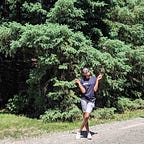This long overdue story wraps up my work on mobile VR development with the Udacity VR Nanodegree program. MazeVR was one of the first experiences I developed that featured some amount of coding (check out my GitHub page for all my work on both PC and mobile games). The objective of MazeVR is to find your way out of the maze and into the temple to collect the treasure.
Unique Considerations
One design consideration I had to make was the size of the play area. Seeing as mazes can get very complicated, it was important to design this one in a way where the maze was not too simple but not so complex that players could get lost easily. I combated this problem by introducing hints by way of adding the richer gold colored walls as a guide which required substantial user testing. Another consideration was the design of the waypoints. I was provided with most of the code for the functionality of the waypoints but had to tweak travel speed to reduce the likelihood of sim sickness.
MazeVR
This project was completed thanks to the continuous iterative process used throughout its development to steadily improve gameplay.
Design Process
Statement of Purpose: MazeVR is a fun and easy mobile VR experience targeted towards new and experienced VR enthusiasts.
Persona
My persona for this project was Eve, a 21-year-old university student who knows little about VR. She is a free spirit who is always interested in trying new things. Eve’s favorite quote is, “Life’s too short.”, so she lives in the moment.
Sketches
Here are some sketches I made to lay the groundwork for the design of the maze. I ended up going for the second one because the first of too complicated!
User testing
Testing motion throughout the scene
As stated earlier, I used waypoints as a way for the player to move around the maze. A problem I encountered when testing was that one of the testers complained of nausea and a slight headache while the other one had no such issue. In response, I decreased the travel speed slightly to a more natural speed for the distance being traveled.
Breakdown of the final piece
Below are some screenshots of the final game design. The start of the game is the entrance to the maze, and the player traverses through to the exit to find a key to the gate of the temple. With the key, the player can open the gate and collect the treasure.
Conclusion
MazeVR is tailored to be a very simple mobile VR game. Features include audio and some visual ques (think particle effects).
Next Steps
To take this game to another level, including a night-like skybox to add some character and a time limit to make things more interesting are some ideas.
Links to additional work
To see some more of my work, visit my GitHub profile. You can get this project at my MazeVR repository in GitHub. Also check out my LinkedIn.
